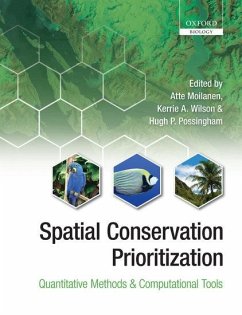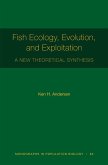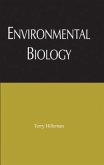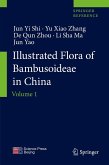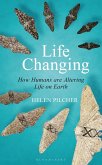Spatial Conservation Prioritization
Quantitative Methods and Computational Tools
Herausgeber: Moilanen, Atte; Possingham, Hugh; Wilson, Kerrie A
Schade – dieser Artikel ist leider ausverkauft. Sobald wir wissen, ob und wann der Artikel wieder verfügbar ist, informieren wir Sie an dieser Stelle.
Spatial Conservation Prioritization
Quantitative Methods and Computational Tools
Herausgeber: Moilanen, Atte; Possingham, Hugh; Wilson, Kerrie A
- Gebundenes Buch
- Merkliste
- Auf die Merkliste
- Bewerten Bewerten
- Teilen
- Produkt teilen
- Produkterinnerung
- Produkterinnerung
In a coherent and comprehensive set of chapters, a team of leading scientists describe the present state-of-the-art in spatial conservation planning methodology with a focus on operational definitions and methods, supported by the latest technological details and applications of publicly available software.
Andere Kunden interessierten sich auch für
![Fish Ecology, Evolution, and Exploitation Fish Ecology, Evolution, and Exploitation]() Ken H AndersenFish Ecology, Evolution, and Exploitation127,99 €
Ken H AndersenFish Ecology, Evolution, and Exploitation127,99 €![Allee Effects in Ecology and Conservation Allee Effects in Ecology and Conservation]() Franck CourchampAllee Effects in Ecology and Conservation121,99 €
Franck CourchampAllee Effects in Ecology and Conservation121,99 €![Environmental Biology Environmental Biology]() Terry Bruce HillemanEnvironmental Biology118,99 €
Terry Bruce HillemanEnvironmental Biology118,99 €![Illustrated Flora of Bambusoideae in China Illustrated Flora of Bambusoideae in China]() Jun Yi ShiIllustrated Flora of Bambusoideae in China560,99 €
Jun Yi ShiIllustrated Flora of Bambusoideae in China560,99 €![Life Changing: Shortlisted for the Wainwright Prize for Writing on Global Conservation Life Changing: Shortlisted for the Wainwright Prize for Writing on Global Conservation]() Helen PilcherLife Changing: Shortlisted for the Wainwright Prize for Writing on Global Conservation21,99 €
Helen PilcherLife Changing: Shortlisted for the Wainwright Prize for Writing on Global Conservation21,99 €![Biodiversity in Drylands Biodiversity in Drylands]() Moshe Shachak / Stewart T. A. Pickett / James R. Gosz / Avi PerevolotskiBiodiversity in Drylands151,99 €
Moshe Shachak / Stewart T. A. Pickett / James R. Gosz / Avi PerevolotskiBiodiversity in Drylands151,99 €![An Anthropogenic Table of Elements An Anthropogenic Table of Elements]() An Anthropogenic Table of Elements96,99 €
An Anthropogenic Table of Elements96,99 €-
In a coherent and comprehensive set of chapters, a team of leading scientists describe the present state-of-the-art in spatial conservation planning methodology with a focus on operational definitions and methods, supported by the latest technological details and applications of publicly available software.
Produktdetails
- Produktdetails
- Verlag: Oxford University Press
- Seitenzahl: 328
- Erscheinungstermin: 3. August 2009
- Englisch
- Abmessung: 191mm x 249mm x 20mm
- Gewicht: 880g
- ISBN-13: 9780199547760
- ISBN-10: 0199547769
- Artikelnr.: 26396076
- Herstellerkennzeichnung
- Libri GmbH
- Europaallee 1
- 36244 Bad Hersfeld
- gpsr@libri.de
- Verlag: Oxford University Press
- Seitenzahl: 328
- Erscheinungstermin: 3. August 2009
- Englisch
- Abmessung: 191mm x 249mm x 20mm
- Gewicht: 880g
- ISBN-13: 9780199547760
- ISBN-10: 0199547769
- Artikelnr.: 26396076
- Herstellerkennzeichnung
- Libri GmbH
- Europaallee 1
- 36244 Bad Hersfeld
- gpsr@libri.de
Atte Moilanen has a background in computer science (MSc 1992), applied mathematics (Licentiate of Technology, Helsinki University of Technology 1998), and spatial ecology (PhD, University Helsinki 1999). Presently (2003-2008) he is a research fellow of the Academy of Finland and vice-director of the Finnish Centre of Excellence in Metapopulation Biology, a leading research group in the study spatial ecology. Atte is also an Associate with the CERF/AEDA Commonwealth funded research hub in applied environmental decision making. Atte is author of more than 40 original publications around the topics of spatial ecology, optimization, and methods for conservation prioritisation. He also is author of multiple pieces of software, including the Zonation package for large-scale conservation prioritisation. Moilanen's present research interests focus on the development of methods, theory and efficient software for application in the field of conservation science. Kerrie Wilson has a background in Environmental Science (BSc, The University of Queensland, BSc, 1999), conservation ecology (PhD, University of Melbourne, 2003), and conservation prioritisation (Post-doc, University of Queensland, 2007). Kerrie was previously the Director of Conservation for the Australia program prior to taking up a senior lectureship at The University of Queensland after being awarded an Australian Research Council fellowship. Kerrie is author of approximately 35 original publications on the topics of spatial conservation prioritisation, threat analysis, and species distribution modelling, including a seminal review on incorporating threats into conservation planning. Her current research interests include the development of frameworks for conservation spending that accounts for threats, costs, ecosystem services, and biodiversity values. Hugh Possingham majored in applied mathematics and biochemistry at The University of Adelaide, followed by a doctorate in biomathematics at Oxford University in 1987. Postdoctoral research periods followed at Stanford University and ANU (as a QEII Fellow). In 1991 he took a Lectureship in Applied Mathematics at the University of Adelaide and was appointed Foundation Chair and Professor of the Department of Environmental Science in 1995. In 2000 Hugh escaped southern Australia to direct The Ecology Centre at The University of Queensland, Brisbane. Hugh is an Australian Research Council Federation Fellow (2006-2010) and a Director of a Commonwealth Environment Research Facility. He has coauthored over 200 publications, 154 in peer-reviewed papers covered by the web of science. His lab includes nine postdoctoral fellows and fourteen PhD students working on empirical and theoretical aspects of biodiversity conservation. In 2005 he was elected to the Australian Academy of Science.
* Preface, Ilkka Hanski
* 1: Simon Ferrier and Brendan A. Wintle: Quantitative Approaches to
Spatial Conservation Prioritization: Matching the Solution to the
Need
* 2: Kerrie A. Wilson, Mar Cabeza and Carissa J. Klein: Fundamental
Concepts of Spatial Conservation Prioritization
* 3: Atte Moilanen, Hugh P. Possingham and Stephen Polasky: A
Mathematical Classification of Conservation Prioritization Problems
* 4: Robert G. Haight and Stephanie A. Snyder: Integer Programming
Methods for Reserve Selection and Design
* 5: Atte Moilanen and Ian Ball: Heuristic and Approximate Optimization
Methods for Spatial Conservation Prioritization
* 6: Jane Elith and John Leathwick: Conservation Prioritization Using
Species Distribution Modelling
* 7: Simon Ferrier, Daniel P. Faith, Anni Arponen, and Michael
Drielsma: Community-level Approaches to Spatial Conservation
Prioritization
* 8: Emily Nicholson and Otso Ovaskainen: Conservation Prioritization
Using Metapopulation Models
* 9: Michael A. McCarthy: Spatial Population Viability Analysis
* 10: Hugh P. Possingham, Atte Moilanen and Kerrie A. Wilson:
Accounting for Habitat Dynamics in Conservation Planning
* 11: Helen M. Regan, Michelle Ensbey and Mark A. Burgman: Conservation
Prioritization and Uncertainty in Planning Inputs
* 12: Reed Noss, Scott Nielsen and Ken Vance-Borland: Prioritizing
Ecosystems, Species, and Sites for Restoration
* 13: Miguel B. Araújo: Climate Change and Spatial Conservation
Planning
* 14: Ian R. Ball, Hugh P. Possingham and Matthew E. Watts: Marxan and
Relatives: Software for Spatial Conservation Prioritization
* 15: Atte Moilanen, Heini Kujala and John R. Leathwick: The Zonation
Framework and Software for Conservation Prioritization
* 16: Robert L. Pressey, Matthew E. Watts, Thomas W. Barrett and
Malcolm J. Ridges: The C-Plan Conservation Planning System: Origins,
Applications and Possible Futures
* 17: Sahotra Sarkar, Trevon Fuller, Anshu Aggarwal, Alexander Moffett
and Christopher D. Kelley: The ConsNet Software Platform for
Systematic Conservation Planning
* 18: Andrew T. Knight, Richard M. Cowling, Hugh P. Possingham and
Kerrie A. Wilson: From Theory to Practice: Designing and Situating
Spatial Prioritization Approaches to Better Implement Conservation
Action
* 19: Atte Moilanen, Hugh P. Possingham and Kerrie A. Wilson: Spatial
Conservation Prioritization: Past, Present, and Future
* References
* Index
* 1: Simon Ferrier and Brendan A. Wintle: Quantitative Approaches to
Spatial Conservation Prioritization: Matching the Solution to the
Need
* 2: Kerrie A. Wilson, Mar Cabeza and Carissa J. Klein: Fundamental
Concepts of Spatial Conservation Prioritization
* 3: Atte Moilanen, Hugh P. Possingham and Stephen Polasky: A
Mathematical Classification of Conservation Prioritization Problems
* 4: Robert G. Haight and Stephanie A. Snyder: Integer Programming
Methods for Reserve Selection and Design
* 5: Atte Moilanen and Ian Ball: Heuristic and Approximate Optimization
Methods for Spatial Conservation Prioritization
* 6: Jane Elith and John Leathwick: Conservation Prioritization Using
Species Distribution Modelling
* 7: Simon Ferrier, Daniel P. Faith, Anni Arponen, and Michael
Drielsma: Community-level Approaches to Spatial Conservation
Prioritization
* 8: Emily Nicholson and Otso Ovaskainen: Conservation Prioritization
Using Metapopulation Models
* 9: Michael A. McCarthy: Spatial Population Viability Analysis
* 10: Hugh P. Possingham, Atte Moilanen and Kerrie A. Wilson:
Accounting for Habitat Dynamics in Conservation Planning
* 11: Helen M. Regan, Michelle Ensbey and Mark A. Burgman: Conservation
Prioritization and Uncertainty in Planning Inputs
* 12: Reed Noss, Scott Nielsen and Ken Vance-Borland: Prioritizing
Ecosystems, Species, and Sites for Restoration
* 13: Miguel B. Araújo: Climate Change and Spatial Conservation
Planning
* 14: Ian R. Ball, Hugh P. Possingham and Matthew E. Watts: Marxan and
Relatives: Software for Spatial Conservation Prioritization
* 15: Atte Moilanen, Heini Kujala and John R. Leathwick: The Zonation
Framework and Software for Conservation Prioritization
* 16: Robert L. Pressey, Matthew E. Watts, Thomas W. Barrett and
Malcolm J. Ridges: The C-Plan Conservation Planning System: Origins,
Applications and Possible Futures
* 17: Sahotra Sarkar, Trevon Fuller, Anshu Aggarwal, Alexander Moffett
and Christopher D. Kelley: The ConsNet Software Platform for
Systematic Conservation Planning
* 18: Andrew T. Knight, Richard M. Cowling, Hugh P. Possingham and
Kerrie A. Wilson: From Theory to Practice: Designing and Situating
Spatial Prioritization Approaches to Better Implement Conservation
Action
* 19: Atte Moilanen, Hugh P. Possingham and Kerrie A. Wilson: Spatial
Conservation Prioritization: Past, Present, and Future
* References
* Index
* Preface, Ilkka Hanski
* 1: Simon Ferrier and Brendan A. Wintle: Quantitative Approaches to
Spatial Conservation Prioritization: Matching the Solution to the
Need
* 2: Kerrie A. Wilson, Mar Cabeza and Carissa J. Klein: Fundamental
Concepts of Spatial Conservation Prioritization
* 3: Atte Moilanen, Hugh P. Possingham and Stephen Polasky: A
Mathematical Classification of Conservation Prioritization Problems
* 4: Robert G. Haight and Stephanie A. Snyder: Integer Programming
Methods for Reserve Selection and Design
* 5: Atte Moilanen and Ian Ball: Heuristic and Approximate Optimization
Methods for Spatial Conservation Prioritization
* 6: Jane Elith and John Leathwick: Conservation Prioritization Using
Species Distribution Modelling
* 7: Simon Ferrier, Daniel P. Faith, Anni Arponen, and Michael
Drielsma: Community-level Approaches to Spatial Conservation
Prioritization
* 8: Emily Nicholson and Otso Ovaskainen: Conservation Prioritization
Using Metapopulation Models
* 9: Michael A. McCarthy: Spatial Population Viability Analysis
* 10: Hugh P. Possingham, Atte Moilanen and Kerrie A. Wilson:
Accounting for Habitat Dynamics in Conservation Planning
* 11: Helen M. Regan, Michelle Ensbey and Mark A. Burgman: Conservation
Prioritization and Uncertainty in Planning Inputs
* 12: Reed Noss, Scott Nielsen and Ken Vance-Borland: Prioritizing
Ecosystems, Species, and Sites for Restoration
* 13: Miguel B. Araújo: Climate Change and Spatial Conservation
Planning
* 14: Ian R. Ball, Hugh P. Possingham and Matthew E. Watts: Marxan and
Relatives: Software for Spatial Conservation Prioritization
* 15: Atte Moilanen, Heini Kujala and John R. Leathwick: The Zonation
Framework and Software for Conservation Prioritization
* 16: Robert L. Pressey, Matthew E. Watts, Thomas W. Barrett and
Malcolm J. Ridges: The C-Plan Conservation Planning System: Origins,
Applications and Possible Futures
* 17: Sahotra Sarkar, Trevon Fuller, Anshu Aggarwal, Alexander Moffett
and Christopher D. Kelley: The ConsNet Software Platform for
Systematic Conservation Planning
* 18: Andrew T. Knight, Richard M. Cowling, Hugh P. Possingham and
Kerrie A. Wilson: From Theory to Practice: Designing and Situating
Spatial Prioritization Approaches to Better Implement Conservation
Action
* 19: Atte Moilanen, Hugh P. Possingham and Kerrie A. Wilson: Spatial
Conservation Prioritization: Past, Present, and Future
* References
* Index
* 1: Simon Ferrier and Brendan A. Wintle: Quantitative Approaches to
Spatial Conservation Prioritization: Matching the Solution to the
Need
* 2: Kerrie A. Wilson, Mar Cabeza and Carissa J. Klein: Fundamental
Concepts of Spatial Conservation Prioritization
* 3: Atte Moilanen, Hugh P. Possingham and Stephen Polasky: A
Mathematical Classification of Conservation Prioritization Problems
* 4: Robert G. Haight and Stephanie A. Snyder: Integer Programming
Methods for Reserve Selection and Design
* 5: Atte Moilanen and Ian Ball: Heuristic and Approximate Optimization
Methods for Spatial Conservation Prioritization
* 6: Jane Elith and John Leathwick: Conservation Prioritization Using
Species Distribution Modelling
* 7: Simon Ferrier, Daniel P. Faith, Anni Arponen, and Michael
Drielsma: Community-level Approaches to Spatial Conservation
Prioritization
* 8: Emily Nicholson and Otso Ovaskainen: Conservation Prioritization
Using Metapopulation Models
* 9: Michael A. McCarthy: Spatial Population Viability Analysis
* 10: Hugh P. Possingham, Atte Moilanen and Kerrie A. Wilson:
Accounting for Habitat Dynamics in Conservation Planning
* 11: Helen M. Regan, Michelle Ensbey and Mark A. Burgman: Conservation
Prioritization and Uncertainty in Planning Inputs
* 12: Reed Noss, Scott Nielsen and Ken Vance-Borland: Prioritizing
Ecosystems, Species, and Sites for Restoration
* 13: Miguel B. Araújo: Climate Change and Spatial Conservation
Planning
* 14: Ian R. Ball, Hugh P. Possingham and Matthew E. Watts: Marxan and
Relatives: Software for Spatial Conservation Prioritization
* 15: Atte Moilanen, Heini Kujala and John R. Leathwick: The Zonation
Framework and Software for Conservation Prioritization
* 16: Robert L. Pressey, Matthew E. Watts, Thomas W. Barrett and
Malcolm J. Ridges: The C-Plan Conservation Planning System: Origins,
Applications and Possible Futures
* 17: Sahotra Sarkar, Trevon Fuller, Anshu Aggarwal, Alexander Moffett
and Christopher D. Kelley: The ConsNet Software Platform for
Systematic Conservation Planning
* 18: Andrew T. Knight, Richard M. Cowling, Hugh P. Possingham and
Kerrie A. Wilson: From Theory to Practice: Designing and Situating
Spatial Prioritization Approaches to Better Implement Conservation
Action
* 19: Atte Moilanen, Hugh P. Possingham and Kerrie A. Wilson: Spatial
Conservation Prioritization: Past, Present, and Future
* References
* Index

